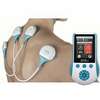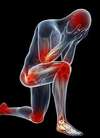Fibromyalgia is attracting growing interest in the medical field. With its chronic diffuse pain, this pathology affects a wide range of people, from young adults to the elderly.
This article looks at fibromyalgia and examines how osteopathy can contribute to multidisciplinary treatment for the patients concerned.
Understanding fibromyalgia
Symptoms of fibromyalgia
Fibromyalgia is a chronic disorder characterized by diffuse muscle and joint pain, persistent fatigue, sleep disturbances and tender points in various parts of the body. These tender points, also known as trigger points, are located in specific areas such as the neck, shoulders, back, hips and knees. These points are particularly sensitive to pressure and can trigger or intensify pain when you touch them. Perceived pain is often described as deep muscle ache, burning or tingling, and may be accompanied by joint stiffness.
Patients may also experience symptoms such as headaches, impaired concentration and memory (commonly known as brain fog), abdominal pain and digestive problems. The severity of symptoms can vary from person to person and fluctuate over time.
Although the exact cause of fibromyalgia is not fully understood, it is thought to be linked to increased sensitization of the central nervous system, leading to increased pain perception.
Fibromyalgia triggers
Although the exact cause of fibromyalgia is not fully understood, several risk factors and potential triggers have been identified:
- the genetic factor. There is evidence to suggest that fibromyalgia may have a genetic component, meaning that it may be more common in people with a family history of the disease.
- environmental factors such as chronic stress, physical or emotional trauma, viral infections and climate change. They can contribute to the development of fibromyalgia or aggravate its symptoms in predisposed individuals.
- gender and age. Women are more likely to develop fibromyalgia than men, with an estimated ratio of around 3:1. Fibromyalgia can appear at any age, but is more common in middle-aged adults, generally between 30 and 60.
- underlying medical conditions such as sleep disorders (such as sleep apnea syndrome), rheumatic disorders (such as rheumatoid arthritis) and autoimmune diseases. These pathologies can increase the risk of developing fibromyalgia or be associated with similar symptoms.
By understanding these potential risk factors and triggers, healthcare professionals can better identify and manage fibromyalgia in patients, tailoring treatment approaches to meet their individual needs.
Different treatments for fibromyalgia
Fibromyalgia treatment is generally aimed at relieving symptoms and improving patients' quality of life. Here's an overview of the different treatments that can be used:
- medication. Various types of medication may be prescribed, such as analgesics to relieve mild to moderate pain, antidepressants to improve sleep, and anticonvulsants to reduce pain and improve various fibromyalgia symptoms. Muscle relaxants can be prescribed to reduce muscle tension and improve sleep quality in fibromyalgia patients.
- physical therapies such as osteopathy, physiotherapy, or a regular exercise program such as walking, swimming or yoga. This can help reduce pain, improve mobility and promote general well-being in fibromyalgia patients. Massage therapy can help relieve muscle tension, improve blood circulation and reduce pain in fibromyalgia patients.
- Psychological approaches such as cognitive behavioral therapy (CBT) can help patients cope with stress, manage emotional symptoms, improve sleep quality and adopt effective coping strategies to manage fibromyalgia. Biofeedback can also help patients become aware of and control their physiological responses, such as muscle tension, to reduce the pain and stress associated with fibromyalgia.
- Complementary and alternative approaches such as acupuncture can be used to relieve pain, reduce muscle tension and improve sleep quality in patients. Transcutaneous electrical nerve stimulation (TENS) can block pain signals. Finally, some patients find relief from fibromyalgia symptoms by taking dietary supplements such as vitamin D, magnesium or omega-3 fatty acids.

It's important for fibromyalgia patients to work closely with their doctor and healthcare team to develop an individualized treatment plan that meets their specific needs and medical situation. A multidisciplinary approach, combining different treatments and approaches, can often be most effective in managing fibromyalgia symptoms and improving quality of life.
Osteopathy in the treatment of fibromyalgia
Purpose of treatment
Osteopathy is a holistic, individualized approach to health care that aims to treat the body as a whole, focusing on the connection between body structure and function. Osteopaths believe that health problems can result from imbalances in the musculoskeletal system, in turn affecting the functioning of other body systems. In the case of fibromyalgia, osteopaths examine not only areas of pain and muscular tension, but also potential contributing factors such as postural imbalances, emotional tensions and lifestyle habits that could aggravate symptoms.
The main aim of osteopathy in the treatment of fibromyalgia is to restore balance in the body, optimize musculoskeletal function and reduce sensitivity at trigger points. Osteopaths aim to alleviate the symptoms of fibromyalgia and improve patients' quality of life.

Techniques used
Osteopaths use a variety of gentle, non-invasive manual techniques to relieve the symptoms of fibromyalgia.
Techniques are used to restore mobility to joints that are stiff or restricted, which can help reduce pain and improve joint function. Stretching and gentle soft-tissue mobilization can help relax tight muscles and improve flexibility, which can reduce muscle stiffness and improve mobility. Myofascial release is a technique aimed at releasing tension and adhesions in the connective tissues (fascia) surrounding muscles and organs. This technique can be particularly effective in relieving pain and muscle tension in fibromyalgia patients.
By combining these techniques with an individualized, holistic approach, osteopaths help fibromyalgia patients to better manage their symptoms, improve their quality of life and regain balance in body and mind.
Conclusion
Fibromyalgia is a complex disease with varied and often changing symptoms. As there is no single identifiable cause, it can be difficult to determine the best treatment approaches for each individual. While osteopathy can offer significant relief for many fibromyalgia patients, it's important to recognize that it may not be effective for everyone. Some patients may experience an improvement in their symptoms, while others may not feel any significant benefit.
If you decide to try osteopathy for fibromyalgia, be sure to work closely with your osteopath and other healthcare professionals to schedule regular follow-up visits to assess your progress and adjust your treatment plan as needed.

